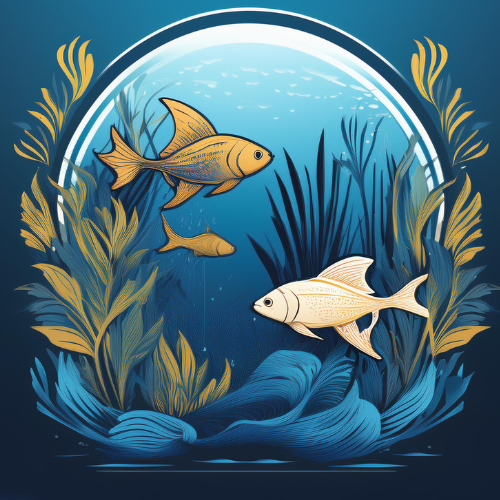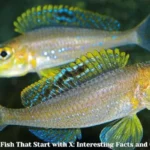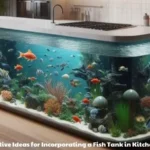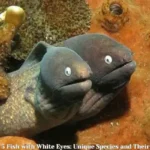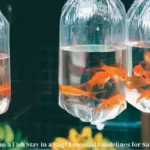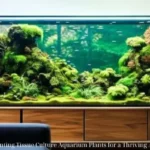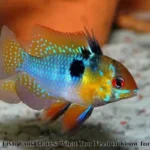Fish care
What Fish Eat Brown Algae: A Complete Guide to Algae-Eating Fish
Brown algae, scientifically known as diatoms, are a common issue in aquariums, especially in new setups. While they are not harmful to fish, they can quickly become unsightly, covering glass, plants, decorations, and substrate with a brownish film. Managing brown algae is crucial for maintaining a clean and aesthetically pleasing aquarium. One effective way to control brown algae is by introducing fish that naturally consume it. In this article, Elegant Aquariums will explore what fish eat brown algae, how they contribute to the ecosystem, and tips for selecting and caring for these algae-eating fish.
Understanding Brown Algae
Before delving into the types of fish that consume brown algae, it’s important to understand what brown algae are and why they appear in aquariums.
What Are Brown Algae?
Brown algae are a type of diatom, a group of microalgae that are commonly found in both freshwater and saltwater environments. They are characterized by their brownish or yellowish-brown color and often form a thin, dusty layer over surfaces in the aquarium. Unlike other types of algae, such as green algae or blue-green algae, brown algae are not typically slimy or stringy but rather appear as a powdery coating.
Causes of Brown Algae in Aquariums
Brown algae are most commonly found in newly established aquariums where the biological filtration system is still maturing. They thrive in low-light conditions and are often associated with high levels of silicates and nitrates in the water. Poor water circulation and low oxygen levels can also contribute to their growth. In some cases, brown algae can appear in mature tanks, especially if there is an imbalance in the water chemistry or inadequate maintenance.
The Role of Algae-Eating Fish in Aquariums
Algae-eating fish play a crucial role in maintaining a healthy and clean aquarium environment. By consuming algae, these fish help prevent excessive algae growth, which can otherwise lead to poor water quality and reduced oxygen levels. Additionally, algae-eating fish can help keep the aquarium looking its best by removing unsightly algae from glass, decorations, and plants.
What Fish Eat Brown Algae

Several species of fish are known for their ability to consume brown algae. Here’s a detailed look at some of the most effective brown algae eaters:
1. Otocinclus Catfish (Otocinclus spp.)
Otocinclus catfish, commonly known as “Otos,” are among the most popular algae-eating fish for freshwater aquariums. These small, peaceful fish are highly effective at consuming brown algae and are especially well-suited for planted tanks.
- Size: Otos are small, typically reaching only 1.5 to 2 inches in length.
- Tank Requirements: A minimum tank size of 10 gallons is recommended, though larger tanks are preferred for groups.
- Diet: In addition to brown algae, Otos will eat other types of algae and biofilm. They can also be fed algae wafers and blanched vegetables like zucchini or cucumber.
- Compatibility: Otos are peaceful and do well in community tanks with other non-aggressive species.
2. Siamese Algae Eater (Crossocheilus oblongus)
The Siamese Algae Eater is another excellent choice for controlling brown algae in freshwater aquariums. These fish are active swimmers and are known for their ability to consume various types of algae, including brown algae, green algae, and even stubborn black beard algae.
- Size: Siamese Algae Eaters can grow up to 6 inches in length.
- Tank Requirements: A minimum tank size of 30 gallons is recommended due to their active nature and potential size.
- Diet: They primarily consume algae but will also eat algae wafers, sinking pellets, and occasional live or frozen foods.
- Compatibility: Siamese Algae Eaters are generally peaceful but can become territorial as they mature. They do well in larger community tanks with plenty of swimming space.
3. Bristlenose Pleco (Ancistrus spp.)
Bristlenose Plecos are popular among aquarists for their algae-eating abilities and unique appearance. These fish are particularly good at scraping algae off surfaces with their specialized mouths.
- Size: Bristlenose Plecos typically grow to about 4 to 6 inches.
- Tank Requirements: A minimum tank size of 20 gallons is recommended, with plenty of hiding spots and driftwood.
- Diet: In addition to brown algae, they enjoy algae wafers, sinking pellets, and blanched vegetables. They also benefit from having driftwood in the tank, which they graze on for fiber.
- Compatibility: Bristlenose Plecos are generally peaceful and do well in community tanks, though they can be territorial with other bottom dwellers.
4. Amano Shrimp (Caridina multidentata)
While not a fish, Amano Shrimp are highly effective at controlling brown algae in freshwater aquariums. These industrious shrimp are constantly foraging and can make a significant impact on algae levels.
- Size: Amano Shrimp grow to about 2 inches in length.
- Tank Requirements: A minimum tank size of 10 gallons is recommended, though larger tanks allow for better stability.
- Diet: Amano Shrimp consume brown algae, biofilm, and leftover food. They can be supplemented with algae wafers and blanched vegetables.
- Compatibility: They are peaceful and do well with most non-aggressive fish. However, they may become prey for larger or predatory fish.
5. Nerite Snails (Neritina spp.)
Again, while not a fish, Nerite Snails are among the best algae-eating invertebrates available to aquarists. These snails are known for their voracious appetite for various types of algae, including brown algae.
- Size: Nerite Snails typically reach about 1 inch in diameter.
- Tank Requirements: A minimum tank size of 5 gallons is recommended, with a secure lid as they are known to escape.
- Diet: They feed on brown algae, green algae, and other algae types. They do not require supplemental feeding if there is sufficient algae in the tank.
- Compatibility: Nerite Snails are peaceful and can be kept with most fish, though they may be at risk in tanks with aggressive species.
6. Florida Flagfish (Jordanella floridae)
The Florida Flagfish is a small, colorful fish that is an excellent brown algae eater. It is particularly effective in combating algae in planted tanks.
- Size: Florida Flagfish grow to about 2.5 inches.
- Tank Requirements: A minimum tank size of 20 gallons is recommended, with plenty of plants and hiding spots.
- Diet: They primarily eat algae, including brown algae, but will also accept flakes, pellets, and live foods.
- Compatibility: Florida Flagfish can be semi-aggressive, so they are best kept with similar-sized, robust tank mates.
Selecting the Right Algae-Eating Fish for Your Aquarium
Choosing the right algae-eating fish depends on several factors, including tank size, water parameters, and the other inhabitants of your aquarium. Here are some considerations to keep in mind:
Tank Size and Layout
Different algae-eating fish have varying space requirements. For example, while Otocinclus Catfish can thrive in smaller tanks, Siamese Algae Eaters need more room to swim. Consider the size of your tank and the amount of swimming space available when selecting an algae-eating fish.
Water Parameters
Ensure that the water parameters in your aquarium are suitable for the algae-eating fish you plan to introduce. Otocinclus Catfish, for example, prefer softer, slightly acidic water, while Florida Flagfish can tolerate a wider range of conditions.
Compatibility with Other Fish
Some algae-eating fish are more peaceful than others. While Otocinclus Catfish and Bristlenose Plecos are generally peaceful, Florida Flagfish can be semi-aggressive. Consider the temperament of your existing fish when choosing an algae eater.
Specific Algae Issues
If you are dealing primarily with brown algae, most algae-eating fish will help control it. However, if you have other types of algae, such as green spot algae or black beard algae, you may need to select a fish or invertebrate that specializes in those types.
Caring for Algae-Eating Fish
Once you’ve selected your algae-eating fish, it’s important to provide proper care to ensure they thrive in your aquarium.
- Providing a Balanced Diet: While algae-eating fish consume algae, it’s essential to supplement their diet with other foods. Algae wafers, blanched vegetables, and sinking pellets can provide the necessary nutrients for their overall health.
- Maintaining Water Quality: Good water quality is crucial for the health of all fish, including algae eaters. Regular water changes, proper filtration, and monitoring of water parameters will help create a stable environment.
- Offering Hiding Spots: Many algae-eating fish, such as Bristlenose Plecos and Otocinclus Catfish, appreciate having hiding spots in the tank. Provide plenty of caves, driftwood, and plants where they can retreat and feel secure.
- Avoiding Overcrowding: Overcrowding can lead to stress and increased competition for resources. Ensure that your tank is appropriately stocked and that there is enough space for all inhabitants to coexist peacefully.
- Monitoring for Signs of Stress or Illness: Regularly observe your algae-eating fish for signs of stress or illness. Indicators can include a lack of appetite, erratic swimming behavior, or physical symptoms like fin rot or discoloration. Early detection and treatment are key to maintaining a healthy aquarium.
- Understanding Lifespan and Growth: Different algae-eating fish have varying lifespans and growth rates. For example, Otocinclus Catfish may live for 3-5 years, while Bristlenose Plecos can live up to 10 years. Understanding these factors can help you plan for the long-term care of your fish.
Alternative Methods for Controlling Brown Algae
While algae-eating fish are effective, they should be part of a broader strategy for controlling brown algae. Here are some additional methods to consider:
Adjusting Lighting Conditions
Brown algae thrive in low-light conditions. Increasing the amount of light in your aquarium, or ensuring that the light is of the correct spectrum, can help reduce their growth. However, be cautious not to overdo it, as this can encourage the growth of other types of algae.
Managing Nutrient Levels
High levels of silicates and nitrates in the water are a primary cause of brown algae. Regular water changes, proper filtration, and the use of a silicate-absorbing filter media can help manage these nutrient levels. Reducing overfeeding and removing decaying plant matter can also limit the nutrients available for algae growth.
Introducing Live Plants
Live plants can outcompete brown algae for nutrients, particularly in well-lit tanks. Fast-growing plants like hornwort, water sprite, or anacharis can be especially effective at keeping algae in check. Additionally, live plants enhance the overall health of your aquarium by absorbing excess nutrients and providing oxygen.
Manual Removal
For persistent brown algae, manual removal may be necessary. Using an algae scraper or pad, you can gently remove algae from glass and decorations. Regular maintenance, including vacuuming the substrate, can also help keep algae levels under control.
Chemical Treatments
In cases of severe brown algae infestations, chemical treatments may be considered. However, these should be used as a last resort, as they can have negative effects on the overall health of your aquarium and its inhabitants. Always follow the manufacturer’s instructions carefully and consider the impact on your fish, plants, and beneficial bacteria.
